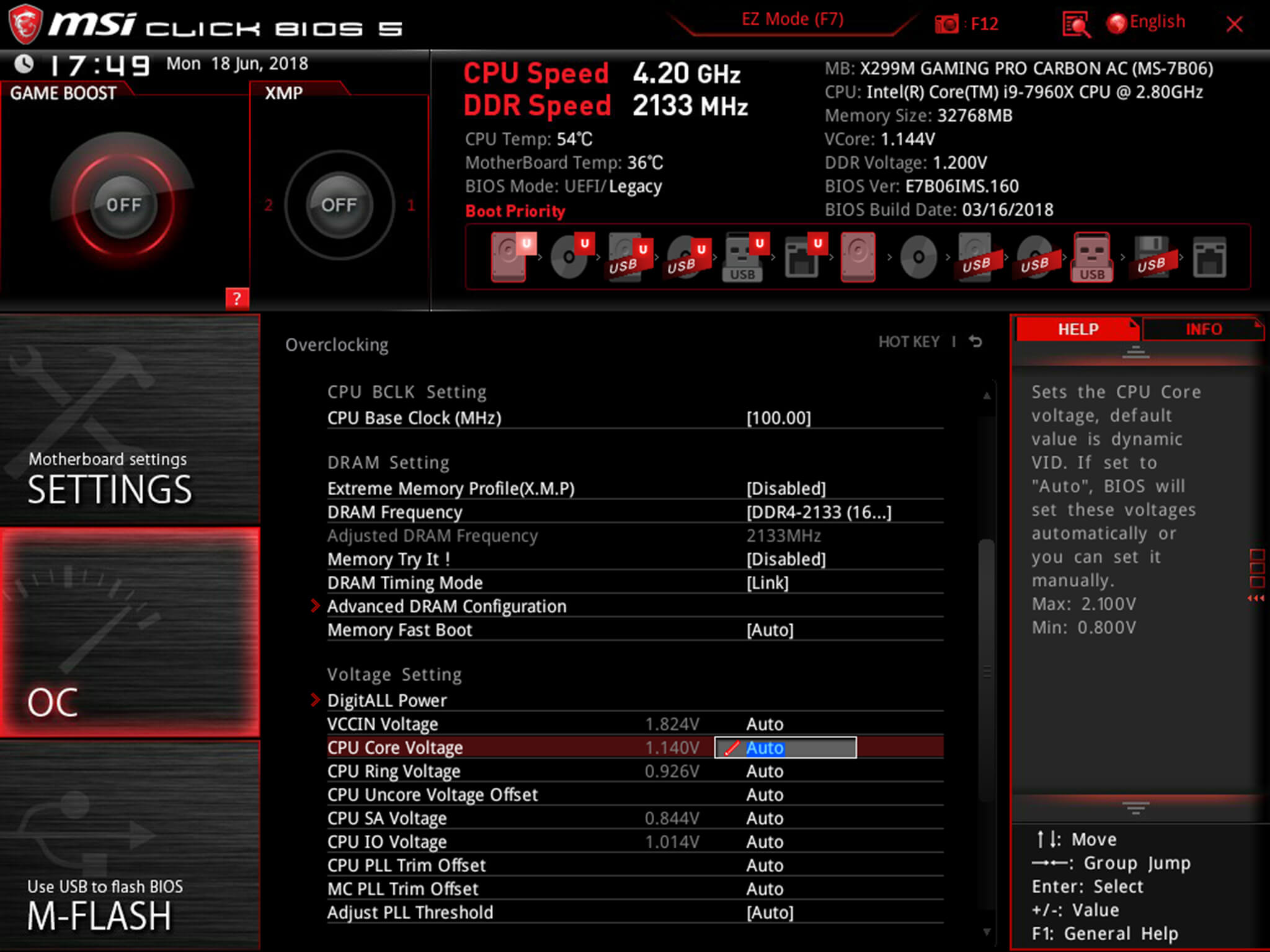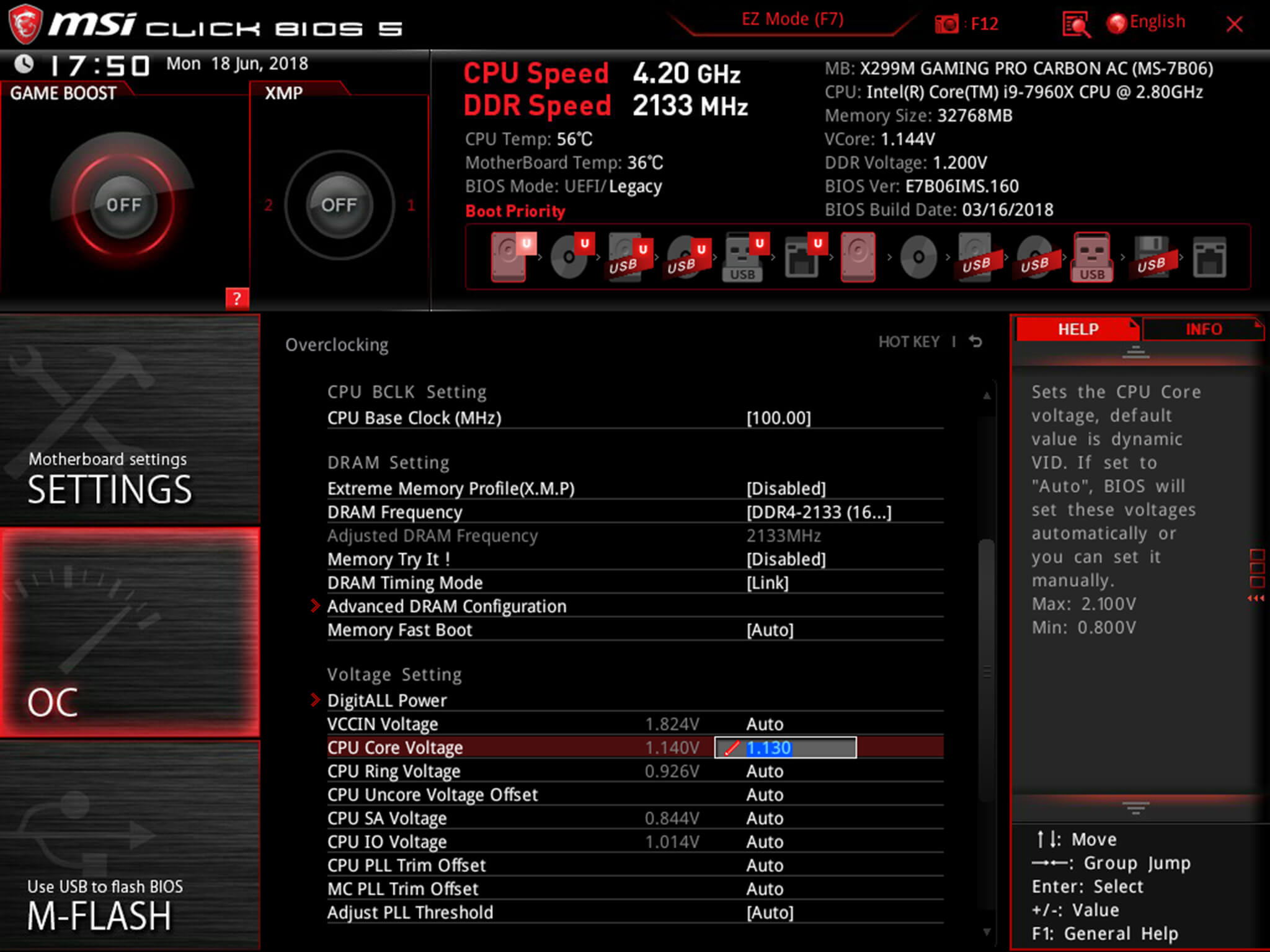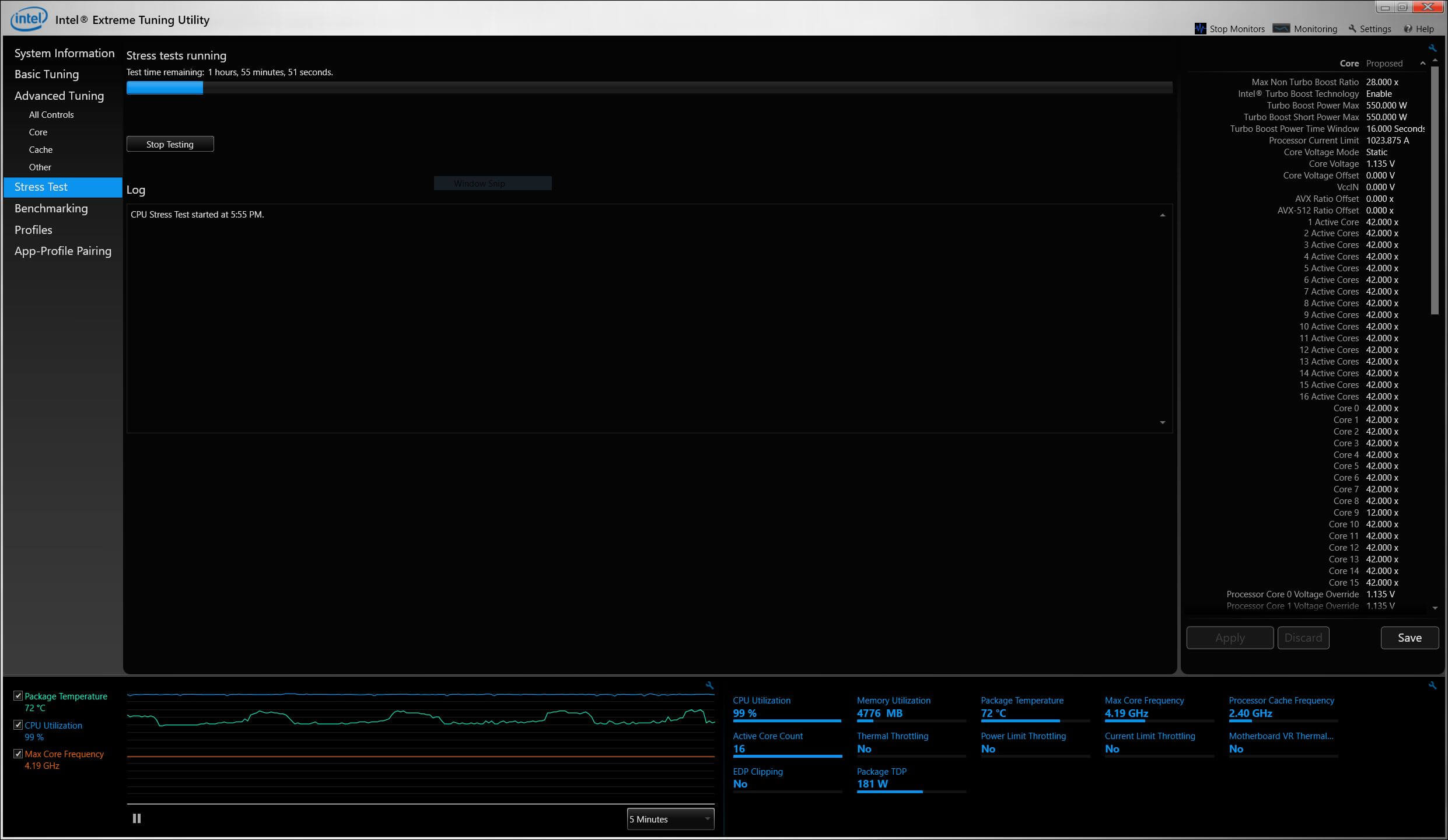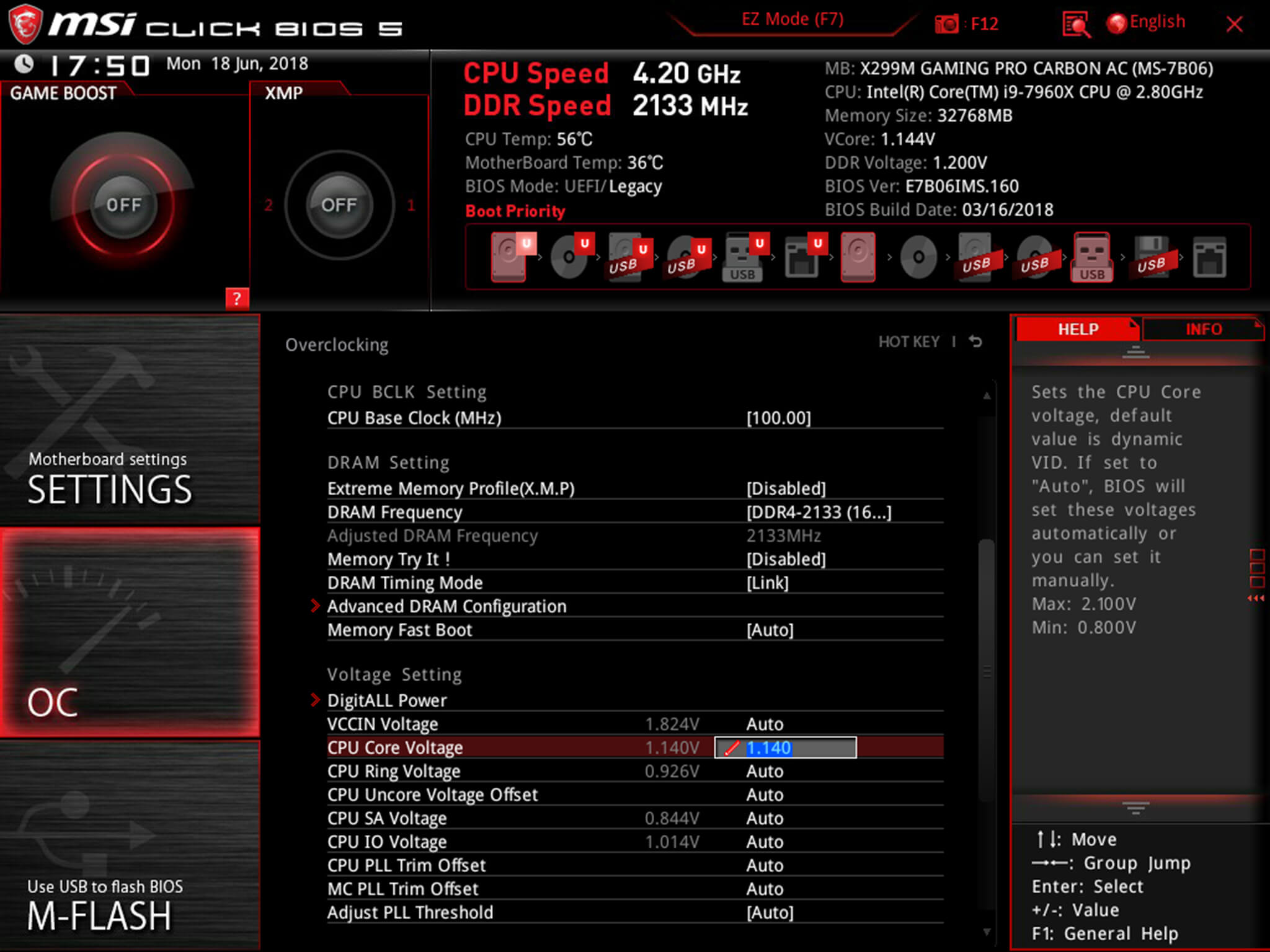The core voltage is different for each processor model, and while all CPUs of the same model have the same VID, not all samples maintain stability at the same clock speeds and Vcore due to slight variations in silicon quality. Every sample of the same CPU model is tested to maintain stability at the default speeds and the VID determined by the manufacturer.
Core voltage typically maintains a constant value while your CPU is in use; however, sometimes under heavy workloads vcore can fluctuate. This is known as Vdroop and can be corrected with load-line calibration. This applies additional voltage as load increases to maintain your CPU's stability.
When it comes to overclocking, you can only push your CPU's frequency so far before your CPU starts to experience instability. Programs might begin to crash or hang up, game performance could suffer or your computer could even fail to boot. This is because your processor isn't getting enough voltage to maintain system stability.
Increasing voltage will allow you to dial in the perfect overclock.
To adjust the voltage, you'll need to boot into your motherboard's BIOS and make adjustments there. The Vcore is expressed as a three decimal value, such as 1.235v. By default, the voltage control is set to auto; this can be overridden by typing in any value. Make sure not to exceed the recommended maximum for your processor.

Before fine-tuning the Vcore, it's important to find a good baseline value for a given speed. This varies from model to model but it can be helpful to read reviews for your CPU, specifically ones that focus on overclocking.
Most publications will list the voltage they required to keep several different speeds stable. Every CPU sample is different and you will need to fine-tune the voltage before calling it done; however, these values do provide a good starting point.

If you boot your machine and don't find any stability issues, then you know it's time to start decreasing the voltage. When overclocking, you want to find the lowest voltage required to maintain stability. More voltage equals more heat and this will allow you to keep temperatures under control.

The safest way to adjust voltage is with increments of .01 volts. Decrease voltage until your computer starts showing signs of instability under load. Use a program like Intel's Extreme Tuning Utility (XTU) or Prime95 to stress test your processor.
If the test fails or crashes, then you need to raise the voltage back up to the previous stable point. For optimal efficiency, you can increase the voltage by .005 instead and again test for stability.

Conversely, if your overclock isn't stable at your baseline voltage, you will then need to increase the voltage until your computer shows no adverse effects and then decrease in increments of .005 to fine tune.

Overclocking is not the only time it can be useful to adjust voltage. As mentioned, higher voltage levels cause your CPU to generate more heat, regardless of frequency. Some CPU samples may have a higher VID than is actually required at the default frequency. Undervolting your processor allows your to maintain stability while decreasing temperatures and extending the life of your processor.
It's a common misconception that disabling Turbo Boost is a more effective substitute for shedding heat. While this does result in decreased temperatures, it is not an alternative as the purpose of undervolting is to maintain the same level of performance while generating less heat. When making adjustments, the same principles apply here as with overclocking, decrease Vcore in increments of .01 and then fine tune with adjustments of .005.
 'The Last of Us' Season 2, episode 5: The spores are here!
'The Last of Us' Season 2, episode 5: The spores are here!
 BYD expects stellar 2023 H1 results, net profit set to triple to RMB 10.5 billion · TechNode
BYD expects stellar 2023 H1 results, net profit set to triple to RMB 10.5 billion · TechNode
 China to take “inclusive and prudent” attitude on ChatGPT
China to take “inclusive and prudent” attitude on ChatGPT
 Apple expands sales reach in China with launch of mini
Apple expands sales reach in China with launch of mini
 Amazon Big Spring Sale 2025: Best portable speaker deal
Amazon Big Spring Sale 2025: Best portable speaker deal
 Semiconductor Industry Association urges restraint on China chip restrictions · TechNode
Semiconductor Industry Association urges restraint on China chip restrictions · TechNode
 Mitsubishi joint venture in China suspends production, plans job cuts · TechNode
Mitsubishi joint venture in China suspends production, plans job cuts · TechNode
 China’s private space company LandSpace launches first liquid oxygen
China’s private space company LandSpace launches first liquid oxygen
 SpaceX's Starlink satellite launch in pictures
SpaceX's Starlink satellite launch in pictures
 Douyin restructures lifestyle services business to compete with Meituan: report · TechNode
Douyin restructures lifestyle services business to compete with Meituan: report · TechNode
 Best portable power station deal: Save 44% on the Jackery Explorer 100 v2
Best portable power station deal: Save 44% on the Jackery Explorer 100 v2
 Videos show Tesla robotaxis appearing to violate traffic laws
Videos show Tesla robotaxis appearing to violate traffic laws
 Geely reportedly set to pump $10 billion into Malaysia production hub · TechNode
Geely reportedly set to pump $10 billion into Malaysia production hub · TechNode
 Hubsan unveils cut
Hubsan unveils cut
 NYT Strands hints, answers for May 2
NYT Strands hints, answers for May 2
 Alibaba withdraws investment from AI company SenseTime · TechNode
Alibaba withdraws investment from AI company SenseTime · TechNode
 Vice president of Xiaomi’s B2B business leaves for VR company iQiyi Smart · TechNode
Vice president of Xiaomi’s B2B business leaves for VR company iQiyi Smart · TechNode
 Top executives from OPPO’s chip unit join autonomous driving company Momenta · TechNode
Top executives from OPPO’s chip unit join autonomous driving company Momenta · TechNode
 NYT Strands hints, answers for April 14
NYT Strands hints, answers for April 14
 Meituan invests in Chinese large language model company Zhipu AI · TechNode
Meituan invests in Chinese large language model company Zhipu AI · TechNode
Shut up and make the hits—Kickstarter's best projects are back with a twistThe struggle is real for Jon Hamm because he's hotMan promises to get Angela Merkel tattoo on his butt for 10,000 upvotes, deliversMartha Stewart's surprising thoughts on 'Millennial Pink'Cloudflare goes down, and takes the internet's security blanket with itWoman replaces her family photos with photos of her dog and it's geniusTrump is running attack ads against TikTok nowWhat it would take for a big box chain like Walmart to go packageEverything coming to Hulu in August 20205 potential Trump theme songs as sung by his lawyer's '70s rock cover band7 women discovered they were dating the same guy via a Snapchat mishap. Whoops.8 essential keyboard tips every iPhone owner should knowSteve Bannon just fatHillary Clinton was spotted at a Broadway musical and everyone freaked outKendall Jenner is too cool to wear a fanny pack on her fannyDisney has reportedly joined the Facebook ad boycottOh good, there's now a swimsuit with Donald Trump's face on itNew emoji in iOS 14 include ninja and pinched fingers5 potential Trump theme songs as sung by his lawyer's '70s rock cover bandQAnon content is no longer welcome on Twitter. Cue the conspiracy theories. Microsoft Surface: The Good, the Ugly and the Unknown NYT Connections hints and answers for May 17: Tips to solve 'Connections' #706. Corsair K70 Mechanical Keyboard deal: Get 41% off Culture Smash: The State of PC Gaming in Japan The Rise and Fall of AMD Best Fire Stick deal: Save $15 on Amazon Fire Stick HD How to unblock Pornhub for free in Oklahoma Boman Martinez Best streaming deal: MUBI is just $3.99 per month for 4 months NYT Strands hints, answers for May 16 The Best Gaming GIFs of 2012 Tesla Cybertruck loses top Chelsea vs. Manchester United 2025 livestream: Watch Women's FA Cup final for free Touring Microsoft, Sony and Apple Stores on Windows 8's Launch Day NASA just performed a 'miracle save' for its farthest spacecraft NYT Strands hints, answers for May 19 Anker SOLIX C1000 Power Station deal: Get $350 off Best cordless vacuum deal: Save $130 on the Samsung Jet 60 at Best Buy Best MacBook Air deal: New M4 MacBook Air for $150 off Building a Thin Mini
2.5775s , 10133.3359375 kb
Copyright © 2025 Powered by 【Wolverine XXX Parody】,Steady Information Network